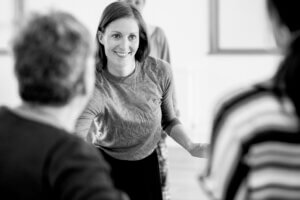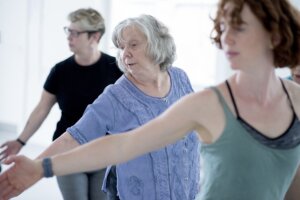
Emily Jenkins, founder and director of Move Dance Feel. Photo credit: Camilla Greenwell Photography
This month, Emily Jenkins, the founder and director of Move Dance Feel, talks about the extraordinary benefits of dance for women living with and beyond cancer, and also for those supporting someone with cancer. Move Dance Feel is a creative community, with a mission to address inequality in cancer care by making dance available to all women living with and beyond cancer. The company unites women affected by cancer through dance and helps them find a renewed sense of joy in the body. As well as being a holistic form of physical activity, dance also provides a creative means of communication, helping participants establish mutually supportive relationships and to process difficult thoughts and emotions, which can be hard to express.
What inspired you to found Move Dance Feel?
My decision to set up Move Dance Feel was informed by experiences I’d had within my close community as I was growing up and by educating myself as to the larger, and very sobering, evidence of need.
I became acutely aware that there was a significant gap in cancer care services and a lack of holistic support especially that of a physical or creative nature.
After treatment, people are often left in the wake of their experience without help or guidance. Research shows that people people’s quality of life deteriorates, and there is little communication with their medical team.
Another motivation for offering dance was in knowing that physical activity has very clear benefits in this context. It is well documented that physical activity after treatment can reduce the risk of recurrence for some cancers, and support emotional wellbeing. It can also help reduce the impact of long-term negative side effects of treatment, and reduce the risk of developing other challenging health conditions as well as cancer.
Physical activity can also benefit people during treatment by helping them maintain their fitness levels and look after their mental health. Sometimes it even helps them respond better to treatment.
Once I became familiar with such a large evidence of need, and knowledgable about the benefits of physical activity in this context, I asked myself ‘why is no one offering dance, when there are so many physical, mental, emotional and social advantages?
Additionally, I had a strong desire to offer safe and creative spaces for women, where we feel accepted and able to move freely – not under the male gaze. Female specific cancers, and treatment approaches, can often be very invasive and life changing, with challenging and long term consequences. I therefore wanted Move Dance Feel to first and foremost be something that united women, through a sense of relatability, nurturing, and collective strength. In our female-only community there is an unspoken understanding, a feeling of being held and a palpable sense of care.

Move Dance Feel unites women affected by cancer through dance. Photo credit: Camilla Greenwell Photography
What are the physical and mental benefits of dance for women living with and beyond cancer?
So many! I encourage you to check out the evidence page on our website to learn about all the ways dance is beneficial in this context.
Our research findings show that dance can alleviate feelings of stress and anxiety – dancing helps to get you out of your head and in the process can calm the mind. Move Dance Feel also improves participants’ energy levels and reduces feelings of fatigue.
Notably dancing can enhance a sense of body appreciation, and reduce feelings of social isolation. As well as support general health and conditioning (balance, cognitive function, coordination) through the physicality of dance.
A lot of women talk about Move Dance Feel being their ‘me time’. For just an hour or two hours you immerse yourself in a creative oasis, which is such a welcome escape from the relentless worry that comes with a cancer diagnosis.
And in terms of mental benefits, the biggest takeaway is that we dance for joy! Dancing can instantly lift our mood, and help us feel good. When this feeling is shared with, and amplified through experiencing with, other people it can lead to enhancements in physical functioning and social engagement – especially because we then feel more motivated to move.
I’ve asked a lot of women to reflect on the dancing, and investigate why it feels good. They tell me:
“I feel more open in my body”
“I feel clearer in thinking”
“I enjoy seeing other people move.”
I invite people to notice what they are feeling during or after dancing. Often they share that they simply feel more energised, and able to breathe more easily.
Additionally, it is evident that there’s huge value in being part of a group who have experienced or still have cancer, but who don’t feel the need to talk about it.
In our community, the centre of focus is on dance not cancer. Women are welcome to share about their cancer if they wish during chat moments, yet most of the time the chats tend to focus on creativity, and general life chat, not so much cancer. Which for many is a welcome relief from the seriousness of it all.

The power of dance and movement builds a real sense of community. Photo credit: Camilla Greenwell Photography
Can anyone with any type of cancer dance? Do you need prior dance experience?
Move Dance Feel is for adult women, with any type of cancer, at any stage in their cancer experience. We also welcome women who are supporting someone with cancer (including health professionals), or bereaved by cancer.
We invite women to move with us as dancers, not as cancer patients.
No prior dance experience is necessary, and there are no requirements in terms of physical ability or energy levels to take part – we offer both standing and seated options.
We really are for all women, whatever their situation. For example one woman in our community has a cancer that keeps coming back (three times). Therefore participants are welcome to dance with us for as long as they feel they need to. We have dancers who are in remission, as well as some with a terminal diagnosis – they dance to better manage their health and importantly, to have fun.
What types of dance do you focus on?
Move Dance Feel focuses on contemporary and creative dance. Specifically, we focus on release techniques and encourage women to find freedom in how they move. We also learn choreographic sequences.
The way we approach dance invites women to reconnect with their bodies, and in the process they often rediscover a sense of control. In an all-female environment this can lead to a sense of empowerment, and have a very positive impact on their sense of confidence. Perhaps that’s one of the reasons that participants really cherish Move Dance Feel being for women only!
Our approach is also about evoking curiosity, and offering the tools you need to reconnect and reinvent.
Importantly, we use the power of dance and movement to build a real sense of community. Many of us may have good friendships, but the way we relate is primarily verbal. In dance we communicate with and through the body. As we move alongside and around one another relationships deepen, often becoming more authentic and intimate. We artist facilitators also explicitly bring ideas into the dance sessions that encourage creative and social exchange between people.
The expressive nature of dance helps participants to establish supportive relationships, as well as process thoughts and feelings that are often difficult to articulate.
How do cancer patients access your workshops?
Free regular sessions of Move Dance Feel are available online via zoom, which allows us to accommodate a nationwide community. The online sessions enable women to take part from the comfort of their own homes, without geographical or logistical barriers.
We also work closely with cancer support organisations and provide in person activity at their centres. Activity ranges from a small series of workshops and one day events to full retreat programmes. You can find out more on our Take Part page, and sign up to our mailing list or follow us on social media to be kept informed about upcoming activities. Instagram, Facebook, Twitter and LinkedIn.
The benefits of joining Cancer Coach
Cancer Support UK’s Cancer Coach programme is available to anyone previously diagnosed with a primary cancer and who has now completed their physical cancer treatment. The course takes participants through a series of weekly facilitated group sessions, run for a six-week period over the telephone or online video. Participants benefit from the peer support of the sessions, as well as learning tools and techniques for improving emotional wellbeing, which can help them on their recovery journey. The course is free, completely confidential and accessible from the comfort and privacy of home.
If you’ve completed cancer treatment, but are experiencing low mood and don’t know how to move forward in your recovery, then please apply to join the course. Simply complete the application form online. If you have any questions, email cancercoach@cancersupportuk.org or call: 020 3983 7616.



